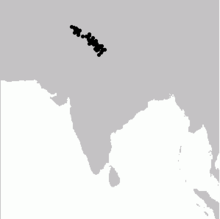Schwarzkopfragopan
| Schwarzkopfragopan | ||||||||||
|---|---|---|---|---|---|---|---|---|---|---|

Black- headed tragopan ( Tragopan melanocephalus ) |
||||||||||
| Systematics | ||||||||||
|
||||||||||
| Scientific name | ||||||||||
| Tragopan melanocephalus | ||||||||||
| ( Gray , 1829) |
The black- headed tragopan ( Tragopan melanocephalus ) is a species from the pheasant-like family. It occurs exclusively in Asia. It is the largest and, together with the Blythtragopan, the rarest species in the Tragopane genus . No subspecies are distinguished.
Appearance
Like all tragopans, the black-headed tragopan exhibits a conspicuous sexual dimorphism. The roosters are brightly colored, with red, brown and black predominating. The full adult plumage is formed in the second year of life. The roosters have short spurs. On both sides of the head they have cones of meat that can be erected by erectile tissue , and on the throat they have a lap-like, thinly feathered and brightly colored, swellable skin. The skull is black, the iris is brown in both sexes. The legs are pink; outside of the reproductive side, the legs are a little paler. The plumage color of the females is dominated by shades of brown.
Males reach a height between 69 and 73 centimeters and weigh between 1.8 and 2.1 kilograms. Females reach an average body length of 60 centimeters and weigh between 1.2 and 1.4 kilograms.
Distribution area and habitat
The black-headed tragopan occurs in the northwest of the Himalayas. The distribution area extends from north Pakistan in an easterly direction via Kashmir and Ladakh in north-west India to the Kattor and Bhilling valleys of the Garwahl. Originally, the black-headed tragopan also occurred further east in India. The species has also been observed in southwestern Tibet.
The black-headed tragopan occurs predominantly in regions that are covered with oaks. These are often Quercus baloot , which grows together with conifers. The altitude distribution extends to heights of 3,600 meters. In the winter half of the year, the black-headed dragopans migrate down the valley and occasionally occur at altitudes of 1,350 meters.
Way of life
The black-headed dragopan is very difficult to observe because it is very shy and mostly stays in the undergrowth. Usually it lives individually or in pairs, only immediately after the reproductive period it is also observed in family groups. It mainly eats in the early morning and late afternoon hours and is then occasionally associated with other pheasants.
The reproductive behavior of the black-headed dragopan has not yet been adequately investigated. It is believed that the species is monogamous. Nests that have been found so far were on the ground, in tree hollows three meters above the ground and in an abandoned nest of another bird species 13 meters above the ground. The clutch comprises two to six eggs.
supporting documents
literature
- Steve Madge , Phil McGowan, and Guy M. Kirwan : Pheasants, Partridges and Grouse. A Guide to the Pheasants, Partridges, Quails, Grouse, Guineafowl, Buttonquails and Sandgrouse of the world. Christopher Helm, London 2002, ISBN 0-7136-3966-0 .
Single receipts
- ↑ Madge et al., P. 281
Web links
- Tragopan melanocephalus inthe IUCN 2013 Red List of Threatened Species . Listed by: BirdLife International, 2012. Retrieved October 7, 2013.
